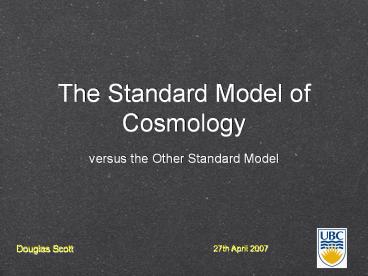The Standard Model of Cosmology - PowerPoint PPT Presentation
1 / 26
Title: The Standard Model of Cosmology
1
The Standard Model of Cosmology
- versus the Other Standard Model
Douglas Scott
27th April 2007
2
Theory of Almost Everything!QFT
THE Standard Model (of Particle Physics)
3
The Standard Model of Cosmology
- Isotropic, homogeneous, expanding (FRW)
- Spatially flat
- Dark Energy and Dark Matter dominated
- Adiabatic, Gaussian, nearly scale-invariant
initial perturbations - Determine parameters (12 in all)
Rest of Astrophysics
From CMB
4
SMPP
SMC
- Early 1990sPredicted6 things (later)Not
fundamental - Observer dependent (time Cosmic Var.)
- Early 1970s
- Predicted
- W,Z,c,t,g,Higgs
- Not fundamental
- Observer independent
5
A,B,C,D,E,F,G,H,I,J,K,L,M,N,O,P,Q,R,S,T,U,V,W,X,Y,
Z
6
A,E,H,I,K,L,M,N,O,P,U,W
7
Vintage of the SMC?
8
Vintage of the SMC?
Nature 348, 705 - 707 (27 December 1990)
doi10.1038/348705a0 The cosmological constant
and cold dark matter G. EFSTATHIOU, W.
J. SUTHERLAND S. J. MADDOX Department of
Physics, University of Oxford, Oxford 0X1 3RH,
UK THE cold dark matter (CDM) model14 for the
formation and distribution of galaxies in a
universe with exactly the critical density is
theoretically appealing and has proved to be
durable, but recent work58 suggests that there
is more cosmological structure on very large
scales (lgt 10 h 1 Mpc, where h is the Hubble
constant H 0 in units of 100 km s1 Mpc1) than
simple versions of the CDM theory predict. We
argue here that the successes of the CDM theory
can be retained and the new observations
accommodated in a spatially flat cosmology in
which as much as 80 of the critical density is
provided by a positive cosmological constant,
which is dynamically equivalent to endowing the
vacuum with a non-zero energy density. In such a
universe, expansion was dominated by CDM until a
recent epoch, but is now governed by the
cosmological constant. As well as explaining
large-scale structure, a cosmological constant
can account for the lack of fluctuations in the
microwave background and the large number of
certain kinds of object found at high redshift.
9
SMC Predictions
Confirmation
1994 1998 2000 2001 2002 2003 2005
- CMB Acoustic Peaks
- Acceleration
- Cosmic Shear
- Cosmic Jerk
- CMB Polarization
- Baryon Acoustic Oscillations
- ISW-LSS Correlation
10
Acoustic Peaks
11
Acoustic Peaks
Peebles Yu (1970)
Sunyaev Zeldovich (1970)
Wilson Silk (1981)
12
(2003)
13
Acceleration
14
Cosmic Shear
E
B
Benjamin et al. (2007)
15
Cosmic Jerk
16
CMB Polarization
17
Baryon Acoustic Oscillations(not Beijing
Astronomical Observatory)
Eisenstein et al. (2005)
18
ISW-LSS Correlation
- Predicted Crittenden Turok (1996)
- 1st limit Boughn Crittenden (2002)
- Flurry of low significance results
- Convincing by 2005
- Smells real, i.e. gets better with time!
19
Beyond the SMC?
- Constrain parameters better?
- Which of 12 have null values?
- 1w and B-modes measurable?
- Will it get as boringly successful as the SMPP?
20
Constraining w
21
Holy Grail No.2 B-Modes?
22
Are some parameters stochastic?(Did someone say
the A word?)
23
Cosmological information (and parameter set)
varies with time!
Moss, Scott Zibin (2007)
24
A new model of the Universe
Anon
25
Natural Dark Energy(with Dr. Frolop, 2007)
- If DE is so great, lets have more!
- Embrace the Dark Side!
- Find most natural set of Dark fluids
26
Natural Dark Energy(with Dr. Frolop, 2007)
- If DE is so great, lets have more!
- Embrace the Dark Side!
- Find most natural set of Dark fluids

